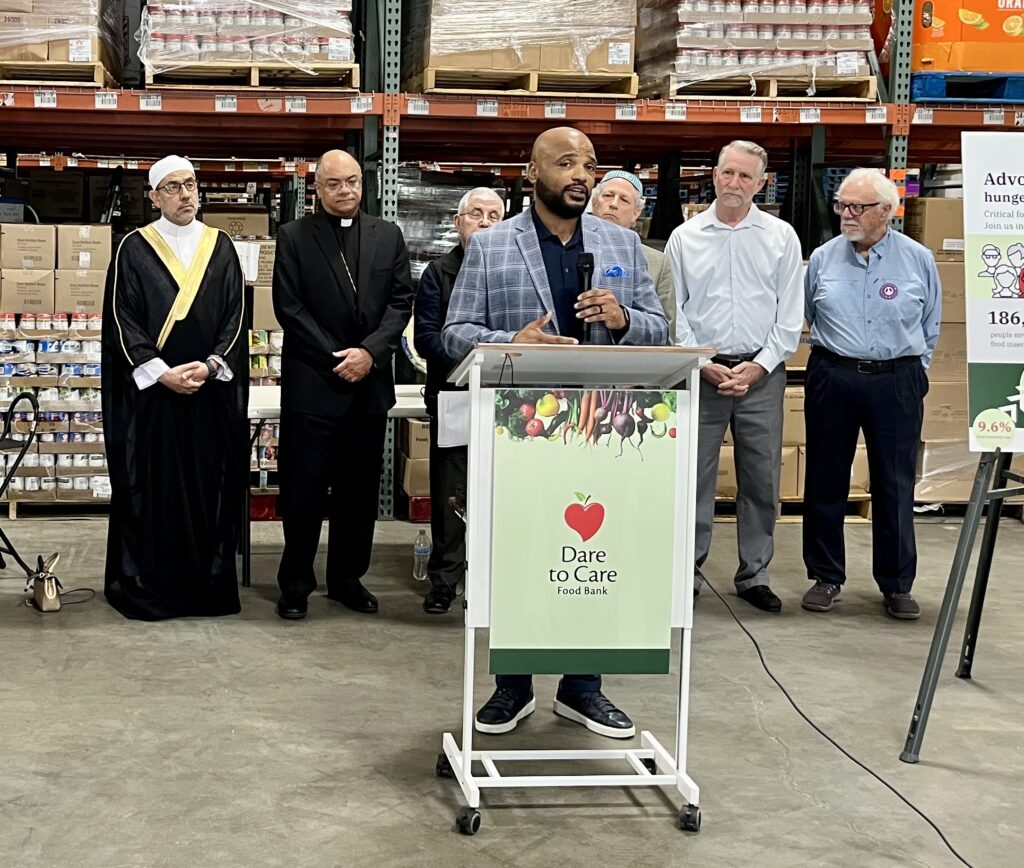Vincent James, president and CEO of a Louisville-based food bank, says more people in the region are unsure where their next meal will come from. Flanked by anti-hunger advocates and religious leaders, he spoke in a Dare to Care warehouse, May 14, 2025. (Kentucky Lantern photo by Sarah Ladd)
LOUISVILLE — Saying “hunger knows no political boundaries,” Dare to Care president and CEO Vincent James urged Congress not to cut Medicaid, SNAP and other safety-net programs.
Doing so could increase an already “unimaginable” spike in food insecurity in the Louisville area and Southern Indiana, James said.
James gathered with anti-hunger advocates and religious leaders in the Dare to Care food bank on Fern Valley Road Wednesday, the same day the nonprofit Feeding America released results from the latest Map the Meal Gap study, showing food insecurity is on the rise in the area.
Over the last two years, Dare to Care has seen a 48% increase in food insecurity in the 13 counties it serves. In Louisville and the surrounding region, 1 in 7 people — including 1 in 5 children — live with food insecurity, which means they don’t have enough to eat and may not know where their next meal will come from.
James said people are feeling the loss of pandemic-era assistance. “If you think back to 2020 when there were a lot of COVID benefits, you had child tax credits, you had so many other benefits that were coming to our community and to individuals to be able to help them to build that bridge of the gap that they had with their resources every month,” James said. “But when those benefits were cut around two or three years ago, we’re now seeing the impact of those cuts.”
With Medicaid and SNAP — the Supplemental Nutrition Assistance Program — facing likely funding cuts in the Republican Congress, there’s a real concern that Dare to Care, which provides food to people who need it in parts of Kentucky and Southern Indiana, won’t be able to keep up, James said.
“If you think about a senior who is getting Social Security and also some other benefits — Medicaid, Medicare — and now (if) those things are being cut, that means that they’ve got to pay for it in some kind of way — the money that they were using, most likely, for food,” James explained. “That’s when we actually see and hear stories where we have seniors who are adding water to soup so it can stretch longer. No one should be in that situation.”
The Dare to Care food bank, May 14, 2025.(Kentucky Lantern photo by Sarah Ladd)
Joining James were religious leaders — Archbishop Shelton J. Fabre from the Archdiocese of Louisville, Imam Muhammad Almoutem of the Muslim Community Center of Louisville, the Rev. Martin Brooks of Peace Catalyst International and several others — who said that their respective faiths call on them to feed all hungry people.
Cantor David Lipp from Congregation Adath Jeshurun called feeding the hungry a religious and moral “mandate.” Fabre said feeding people is a way to recognize “basic human dignity.”
Almoutem said “ignoring the people in need, and in particular the hungry people, is a form of sin” in his religion.
These faith leaders gathered in support of Dare to Care and the continued funding of programs to feed and otherwise help people to, as James said, show a united front in the message that “no one will go hungry in our community again.”
James added: “We’re deeply concerned about the increase of food insecurity that we’ve seen, the lack of access to being able to have access to fresh food we’ve seen, simultaneously faced with the threats and cuts to some of the nutritious programs that are run by our federal government.”
Map the Meal Gap
The 2025 Map the Meal Gap report, based on data from 2023, shows that about 70% of food insecure Kentuckians fall below the threshold that qualifies them for SNAP benefits; about 30% are above it.
In total, 753,410 Kentuckians are food insecure, according to the report. In 2019, before the COVID-19 pandemic, that number was 644,540.
Children, people of color, the LGBTQ+ community, immigrants, people with disabilities, formerly incarcerated people, single-parent households and people living in the South. are more likely to be food insecure, according to the report.
Overall, nearly 17% of Kentuckians have a shortage of food, the new data shows.
Other data points from the report showed that nationally:
-
Hungry people live in all — 100% — of counties and congressional districts.
-
Child food insecurity affects every county and district, with rates reaching almost 50% in some areas.
-
More than 12 million seniors and older adults experience food insecurity.
-
86% of counties with the highest food insecurity are in the South.
-
86% of counties with the highest food insecurity are rural.
-
Among counties with available estimates, rates of food insecurity for Black or Latino individuals reach nearly 60%.
-
More than 2 out of 5 people facing hunger are unlikely to qualify for Supplemental Nutrition Assistance Program (SNAP).
-
The national food budget shortfall has risen to more than $32 billion.
-
The national average cost per meal is $3.58 in 2023.
-
County meal costs range from $2.60 to $6.09.
Addressing this need is a “bipartisan effort,” James said. “We cannot afford any cuts to programs that are providing nutritious food for our neighbors.”
“Every side knows that every human deserves the right to eat. It’s not even a question of a political stance,” he said. “It’s a question of your humanity, that each person has to have an opportunity to have access to food.”

A crate of oranges in the Dare to Care food bank, May 14, 2025.(Kentucky Lantern photo by Sarah Ladd)
Read the full article here


